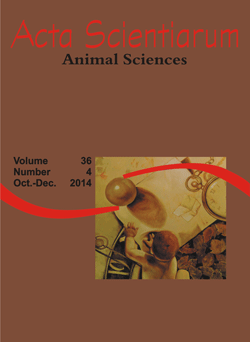<b>Whole rice in japanese quails’ diet
Resumo
A trial was conducted to evaluate the use of dehulled and unpolished whole rice in Japanese quails’ diet. A total of 100 80-days-old Japanese quails (149.07 ± 10 g) were distributed in five treatments: 0% dehulled and unpolished whole rice (control diet based on corn and soybean meal), 20, 40, 60, and 80% of whole rice in replacement of corn; respectively, treatments 1, 2, 3, 4, and 5. Productive performance was evaluated through egg production (%), egg weight (g), body weight (g), egg mass (g), feed conversion per egg mass and feed conversion per dozen eggs. The following variables measured the internal quality of eggs: albumen height (mm), yolk color and percentage, egg white percentage and Haugh units. The external quality of eggs was measured through specific gravity (g cm-3), shell thickness (µm) and shell percentage. Treatment means were analyzed through polynomial regression at 5%. As the level of whole rice was increased in the diets, a significant linear increase in egg production (p = 0.005), egg mass (p = 0.007), shell thickness (p = 0.03) and specific gravity (p = 0.007) was observed. Feed conversion per egg mass (p = 0.006), feed conversion per dozen eggs (p = 0.003) and egg color (p < 0.0001), on the other hand, were reduced linearly. The increased utilization of whole rice increased the cost of the diet. In conclusion, the addition of dehulled and unpolished whole rice in partial substitution of corn in Japanese quails’ diets increases the egg production and reduces the yolk color.
Downloads
DECLARAÇÃO DE ORIGINALIDADE E DIREITOS AUTORAIS
Declaro que o presente artigo é original, não tendo sido submetido à publicação em qualquer outro periódico nacional ou internacional, quer seja em parte ou em sua totalidade.
Os direitos autorais pertencem exclusivamente aos autores. Os direitos de licenciamento utilizados pelo periódico é a licença Creative Commons Attribution 4.0 (CC BY 4.0): são permitidos o compartilhamento (cópia e distribuição do material em qualqer meio ou formato) e adaptação (remix, transformação e criação de material a partir do conteúdo assim licenciado para quaisquer fins, inclusive comerciais.
Recomenda-se a leitura desse link para maiores informações sobre o tema: fornecimento de créditos e referências de forma correta, entre outros detalhes cruciais para uso adequado do material licenciado.








































